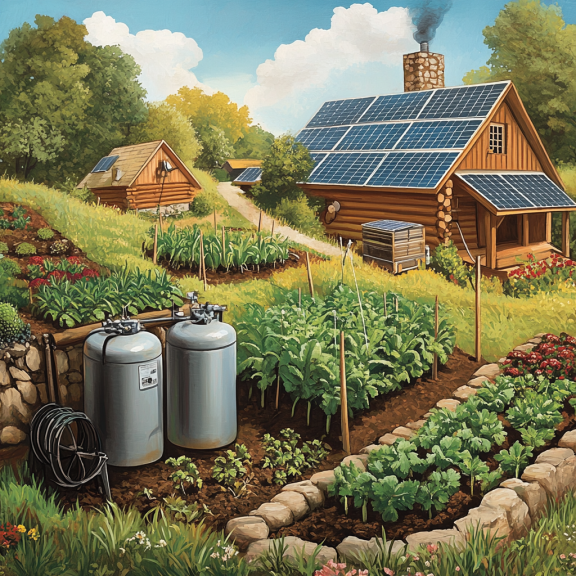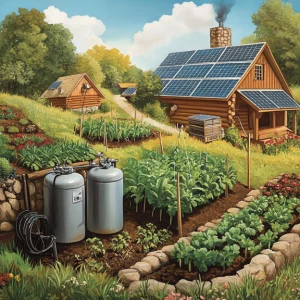Imagine a life unbound by the constraints of traditional utility grids, where energy comes from the sun and wind, water from the rain, and food from the rich soil of your own backyard. This isn’t a scene from a distant utopia, but a practical reality for those embracing off-grid living. With advancements in technology and a growing desire for sustainability, more individuals are turning to this lifestyle, seeking not only to reduce their environmental footprint but also to gain a sense of independence and self-sufficiency.
Off-grid living requires a blend of old-world knowledge and cutting-edge technology. From solar panels capturing the sun’s bounty to harnessing the power of propane and natural gas wells, this lifestyle demands a comprehensive understanding of various systems and their integration. Additionally, the ability to cultivate one’s own food and manage water resources adds layers of gratification and challenge, embodying the essence of a self-reliant life.
As the world becomes increasingly connected, even the most remote locations can access global networks, thanks to services like Starlink Internet. This connectivity not only breaks down the barriers of isolation often associated with off-grid living but also opens up a world of opportunities for remote work, education, and entertainment. This guide dives deep into the how-tos of setting up an off-grid home, highlighting the joys and hurdles of a lifestyle that’s as rewarding as it is demanding.
I. Why Go Off-Grid?
Off-grid living represents the epitome of freedom and self-sufficiency in a world that often seems dominated by dependency on centralized systems. At its core, going off-grid is the ultimate act of declaring independence from the mainstream—choosing a life less ordinary, but filled with potential. It’s not just about reducing your environmental impact through sustainable living practices, although that’s a significant draw. It’s also about gaining control over your life in a very direct and tangible way. By disconnecting from municipal power, water, and other utilities, you not only dodge those pesky monthly bills but also challenge the status quo, embracing a lifestyle that prioritizes resilience and resourcefulness. This way of life appeals to those who seek to minimize their footprint on the earth, offering a more harmonious existence with nature, where every drop of water and ray of sunlight counts.
Making the Shift.
Transitioning to an off-grid lifestyle isn’t merely a change of scenery; it’s a transformative journey that redefines what it means to live independently. It’s not a simple stroll through the park—it’s akin to a hike up a steep and rugged mountain. The path is challenging, marked by obstacles and surprises, but the rewards at the summit are incomparable—true freedom and a profound sense of accomplishment. However, the practical steps to achieving this independence are non-trivial.
- Location, location, location—finding the perfect spot is more than just a real estate mantra; it’s a fundamental cornerstone of off-grid living. The ideal location offers not just beauty and seclusion but also accessibility to essential resources such as water, fertile soil for cultivation, and ample sunlight for solar power. Additionally, the legal framework governing land use in your chosen location must permit the type of off-grid installations and lifestyle you envision.
- Community connections also play a pivotal role. Transitioning to off-grid life doesn’t mean isolating yourself. On the contrary, forming strong bonds with fellow off-gridders can provide a network of support, advice, and camaraderie. Shared experiences and challenges forge connections that are both practical and enriching, turning neighbors into valuable allies in your off-grid adventure. These relationships can become crucial, especially when facing the logistical and technical challenges of off-grid living, from installing solar panels to managing water resources
II. Harnessing Solar Power
Soak Up the Sun
Solar energy is far more than a mere supplement to traditional power sources; it’s the cornerstone of off-grid living, transforming sunlight into a reliable and sustainable energy supply. Setting up a solar haven might sound complex, but it really isn’t akin to rocket science. The essentials include solar panels, which capture the sun’s energy; batteries, which store this power for use during nighttime or cloudy days; a charge controller, to regulate the power flowing to and from the batteries, ensuring they don’t overcharge; and an inverter, which converts the stored DC power into AC power that can be used to run household appliances.
When choosing components, it’s important to consider the balance between efficiency, cost, and durability. Panels with higher efficiency rates convert more sunlight into energy, but they also come with a higher price tag. Similarly, battery choice will impact how much energy you can store and for how long, affecting your capacity to sustain power during periods without sufficient sunlight. Planning your solar setup involves assessing your typical energy usage and ensuring your system is scaled appropriately to meet your needs without excessive oversizing. Remember, the sun is your most reliable ally in the off-grid environment, providing a daily dose of energy that’s both clean and renewable.
Maintenance and Mischief
Like any robust system, a solar setup requires ongoing attention to operate at its best. Regular maintenance is not just beneficial; it’s essential to prolong the life of your investment and ensure it continues to meet your energy needs efficiently. Simple tasks such as cleaning solar panels to remove dust, debris, or snow that could block sunlight can significantly impact their efficiency. Checking connections for corrosion, wear and tear, and ensuring that batteries are kept at recommended charge levels will prevent long-term damage and keep the system running smoothly.
However, even with the best maintenance, mischief can occur—systems might falter, and components may fail. This is where a good dose of DIY spirit comes in handy. When issues arise, rolling up your sleeves, grabbing your toolset, and consulting the manual can often save a call to a professional. For more complicated problems, or when you’re out of your depth, turning to online resources like YouTube can be incredibly helpful. The platform is rich with tutorials and troubleshooting videos shared by experienced off-gridders and solar enthusiasts. Engaging with the community through forums or local groups can also provide practical advice and sometimes hands-on assistance from those who have tackled similar issues.
By staying informed and proactive about the care of your solar system, you ensure that it continues to provide reliable energy, keeping the lights on and the water hot, no matter what challenges you might face. This not only enhances your self-sufficiency but also deepens your connection to the very essence of off-grid living—embracing independence through informed and mindful living.
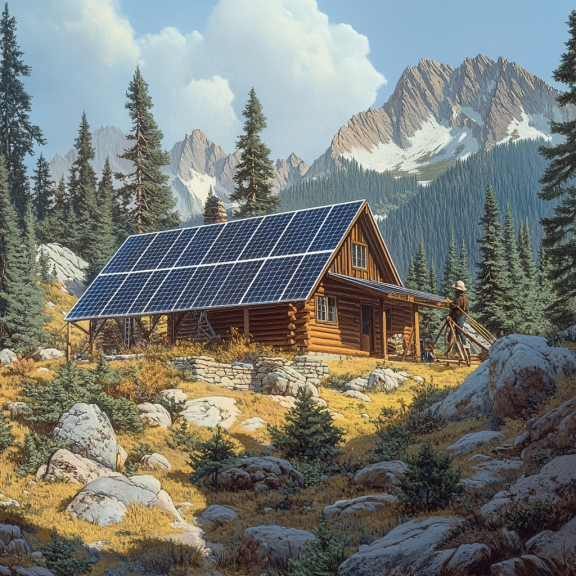
III. Utilizing Propane and Natural Gas
The Dynamic Duo
In the realm of off-grid energy solutions, propane and natural gas stand out as the dynamic duo, providing a versatile and potent source of power for a variety of needs. Propane, in particular, is a popular choice for off-gridders due to its portability and high energy content. It can be easily stored in tanks and used to fuel everything from heating systems and stoves to refrigerators and water heaters. Its efficiency and availability make it a reliable resource even in remote locations where natural gas pipelines do not reach.
Natural gas, while typically more tied to grid infrastructure, can also be an invaluable off-grid resource when wells are accessible. It burns cleaner than many other fossil fuels and is effective for heating, cooking, and powering appliances. The reliability of both propane and natural gas means that you can enjoy a comfortable lifestyle with fewer interruptions, as these fuels are less susceptible to the vagaries of weather and daylight that can affect solar and wind power systems.
Drilling for Gold
Venturing into the world of drilling your own natural gas well is an ambitious endeavor that epitomizes the spirit of off-grid living: independence and self-reliance. However, this is not a task to be taken lightly. The process requires a significant investment in terms of time, money, and regulatory navigation. You’ll need the right permits, which vary significantly by region and will dictate the extent to which you can drill. These permits ensure that your drilling practices are safe and environmentally sound, complying with all local, state, and federal regulations.
The actual drilling process requires patience and precision, as well as a bit of geological luck. You need to identify a suitable site where gas is likely to be found, which often involves geological surveys and expert consultation. The investment in drilling equipment and the hiring of experienced professionals can be substantial, but the payoff is the potential for a long-term, cost-effective energy supply. When you do strike natural gas, the benefits are considerable. Not only can you achieve greater energy independence, but you also have the capability to store excess gas that can be used during emergencies or sold back to local utilities in some areas.
Both propane and natural gas offer robust solutions for the energy needs of off-grid living. Whether you’re buying and storing propane or tapping into natural gas reserves, these fuels can significantly enhance your living quality and sustainability in remote locations. Each has its own set of challenges and benefits, but together, they form an essential part of the energy mix for any serious off-gridder. By understanding and managing these resources wisely, you can secure a reliable and efficient energy system that supports your off-grid aspirations.
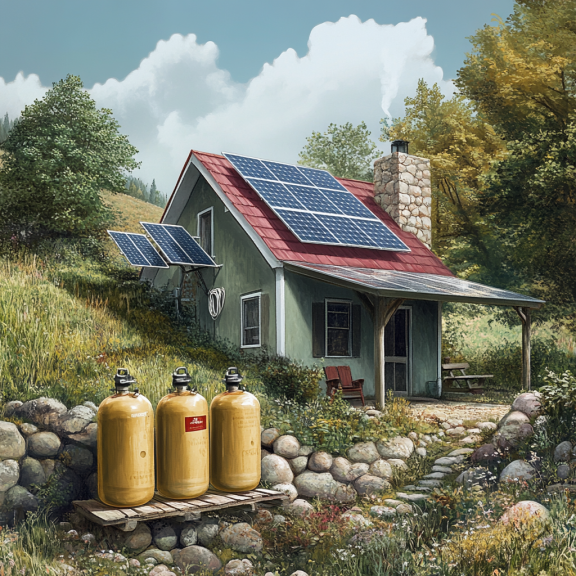
IV. Cultivating Your Own Food
Your Green Thumb
Embracing the art of gardening while living off-grid is like painting a masterpiece; it demands vision, patience, and a splash of creativity. The canvas here is your land, and the paints are the crops you choose to nurture. The key to a flourishing garden is selecting plants that are not only adapted to your local climate but that also complement and support each other. This concept, known as companion planting, can enhance plant growth and help control pests naturally.
Before you break ground, planning is crucial. Assess your land’s soil type, sun exposure, and water availability. These factors will determine which plants will thrive and how you should layout your garden. For instance, leafy greens might prefer shaded areas while tomatoes bask in the sun. Moreover, understanding your climate zone will guide you in selecting crops that can grow well in your specific environmental conditions. This might mean hearty root vegetables for colder climates or drought-resistant plants in arid regions.
Starting your garden also involves preparing the soil, which is the foundation of good plant health. Begin by testing the soil to understand its nutrient content and pH level. Enhancing your soil with organic matter like compost can improve its structure, water retention, and fertility. This natural amendment not only feeds your plants but also promotes a healthy ecosystem within your garden by encouraging beneficial microbes and worms.
As your garden grows, regular maintenance—watering, weeding, pruning, and harvesting—becomes part of your daily routine. Each task is an opportunity to connect with the earth and observe the subtle changes and developments in your garden. Watering in the cool of the morning or evening reduces evaporation and ensures that plants get the most benefit. Meanwhile, keeping on top of weeding prevents unwanted plants from stealing nutrients and sunlight from your crops.
The rewards of your labor can extend beyond the satisfaction of self-sufficiency. Imagine the joy of walking out to your garden to pick fresh ingredients for your meals. Hosting farm-to-table dinners allows you to share the bounty of your land with friends and family, turning meals into a celebration of local produce and homemade dishes.
In essence, cultivating your own food transforms your relationship with what you eat. It makes you an active participant in the cycle of growth and sustenance, providing a profound sense of connection to the natural world. Plus, it enhances your off-grid living experience, adding flavor and vitality to your daily life.

V. Let's talk about water
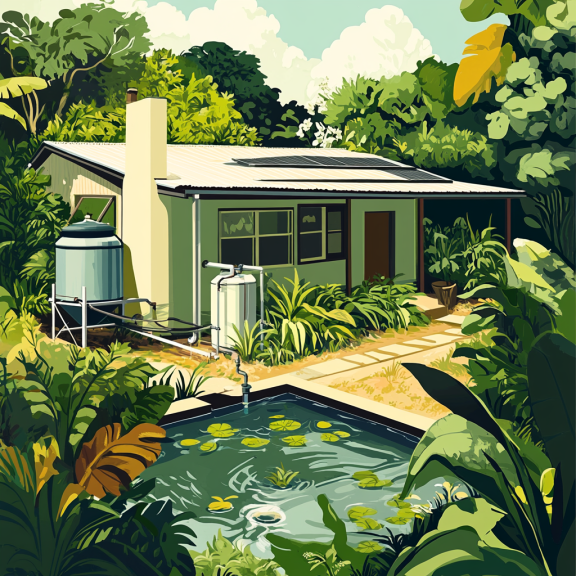
The Value of Every Drop
In the realm of off-grid living, water isn’t just a resource—it’s a lifeline. Thus, managing it wisely is akin to guarding a treasure. Strategies such as rainwater collection and greywater reuse not only conserve water but also reflect a deep understanding of sustainability. Greywater, which is relatively clean waste water from baths, sinks, washing machines, and other kitchen appliances, can be reused for irrigation and other non-potable uses, reducing the overall water consumption significantly.
To optimize water usage, consider the layout of your land and the placement of your home. By designing your living space to facilitate the collection and reuse of water, you can ensure that no drop goes to waste. Simple changes, like redirecting runoff from roofs into storage barrels or creating a natural landscape that directs rainwater to where it’s most needed, can have profound effects on your water reserves. Moreover, incorporating water-saving fixtures and appliances in your home can dramatically reduce your daily water usage, making your off-grid lifestyle more sustainable.
Water Harvesting Techniques
Rainwater harvesting isn’t merely a clever choice; it’s a cornerstone of sustainable off-grid living. Whether you use simple barrels placed strategically under downspouts or invest in more elaborate systems that include large storage tanks and filtration systems, every setup plays a crucial role. The basic principle involves catching rainwater from rooftops, which is then directed into storage vessels. From there, it can be filtered and purified for drinking or used as-is for agricultural and landscaping needs.
For those looking to get the most out of their rainwater harvesting system, integrating first flush diverters and fine mesh filters can improve water quality by removing debris and contaminants from the initial flow of rainwater. Additionally, incorporating a rain garden or other biofiltration systems can enhance the aesthetics of your property while providing a passive filtration system to increase the usability of collected rainwater.
Implementing these water harvesting techniques ensures that your garden remains lush and your household remains functional, even during dry spells. It reduces dependence on external water sources, which is particularly valuable in remote or arid regions where water may not be easily accessible. Moreover, it contributes to the health of local aquifers by reducing runoff and allowing more rainwater to soak into the ground rather than flowing into storm drains.
Together, being water-wise and employing effective water harvesting techniques form a comprehensive approach to water management in off-grid living. They not only ensure a reliable water supply but also promote a sustainable lifestyle that respects and conserves natural resources.
VI. Achieving Connectivity with Starlink Internet
The Sky’s the Limit
Gone are the days when choosing to live off-grid meant cutting oneself off from the digital world. Thanks to advancements in satellite technology, off-gridders no longer have to sacrifice connectivity for autonomy. Starlink, a satellite internet service developed by SpaceX, is revolutionizing how remote dwellers access the internet, bringing high-speed connectivity to the furthest and most secluded corners of the globe.
Starlink’s approach involves a constellation of low Earth orbit satellites that provide a broadband internet connection directly to user terminals on the ground. This technology is particularly game-changing for off-grid communities, as traditional broadband solutions like cable or fiber-optic services are often unavailable in remote areas. With download speeds comparable to, and sometimes surpassing, urban broadband networks, Starlink users can enjoy seamless streaming, browsing, and video calls, all from the tranquility of their off-grid sanctuaries.
Installation and Beyond
Setting up Starlink is straightforward, designed with user-friendliness in mind to accommodate those who might not be tech-savvy. The kit includes a satellite dish, a mounting tripod, and a Wi-Fi router. Installation generally involves finding a clear view of the sky, which the Starlink app helps users determine via augmented reality. Once the optimal location is found, the satellite dish, affectionately nicknamed “Dishy McFlatface” by the Starlink community, automatically aligns itself to receive the best signal. This plug-and-play setup means that even those who aren’t particularly technologically inclined can achieve a reliable internet connection within minutes of unpacking their kit.
The impact of such connectivity on off-grid living cannot be overstated. It not only allows for communication with the wider world but also opens up possibilities for remote work, online education, and access to emergency services, which are crucial for those living away from urban centers. Moreover, with ongoing improvements and the continuous launch of additional satellites, the service is only expected to get faster and more reliable.
Starlink is thus breaking the traditional barriers associated with off-grid living, proving that one can enjoy the peace and sustainability of remote living without losing touch with the pace and progress of modern life. The sky truly is the limit when it comes to what can be achieved with this innovative satellite internet technology.
VII. Conclusion
Embarking on an off-grid adventure is akin to setting sail into the unknown: it’s thrilling, a bit daunting, but ultimately, it’s a journey towards discovering your true potential for self-reliance. Through solar power, propane and natural gas, the cultivation of your own food, and innovative solutions like Starlink, off-grid living offers a blend of ancient wisdom and cutting-edge technology. It’s a lifestyle that challenges you to rethink what’s essential, encourages you to reconnect with nature, and, most importantly, empowers you to take control of your environmental impact.
Remember, off-grid living isn’t just about surviving; it’s about thriving. It’s about creating a life that’s not only sustainable but also fulfilling in every sense of the word. So, as you ponder the possibility of cutting ties with the grid, consider this not just a change in where you live, but a transformation in how you live.
As you turn the last page of this super guide, let it not be the end but the beginning of your quest for independence and harmony with the environment. The path may not always be easy, but the rewards — a life of freedom, sustainability, and profound connection with the natural world — are immeasurable. Welcome to the off-grid lifestyle, where every day is an opportunity to live intentionally, sustainably, and freely.
VIII. FAQs
What are the initial costs associated with transitioning to off-grid living?
A: The initial costs can vary widely depending on location, the size of your dwelling, and the type of technologies you implement. A basic solar setup can range from $5,000 to $20,000, while additional costs for water harvesting systems and septic tanks can add several thousand more. Costs can increase with the addition of high-capacity batteries, larger solar arrays, or more sophisticated water systems. It’s also important to factor in any costs for land, building materials, and permits.
Is off-grid living legal everywhere?
A: Not necessarily. Off-grid living legality depends heavily on local laws and regulations, which can vary dramatically from one place to another. Some areas may have strict zoning laws that require connections to municipal water and power services, while others might have more lenient regulations. Always check with local authorities and zoning boards to understand what is allowed before making any commitments or investments.
How do I ensure a reliable water supply when living off-grid?
A: Ensuring a reliable water supply involves a combination of rainwater harvesting, well drilling (if feasible), and conservation practices. Rainwater harvesting systems can collect and store water during rainy seasons to use during drier periods. If groundwater is accessible, drilling a well can provide a steady water source. Additionally, implementing water-saving fixtures and practices like using greywater systems for irrigation can help extend your water reserves.
What are the challenges of maintaining internet connectivity in remote locations?
A: The primary challenge is finding a service that provides adequate speed and reliability. Satellite internet, such as Starlink, has emerged as a viable solution, offering broadband speeds that can support streaming, downloads, and regular online activities. However, the initial setup cost and monthly service fees can be higher than traditional services. Weather conditions and physical obstructions like trees can also affect connectivity.
Can I generate enough power to run a typical household by using solar panels and propane?
A: Yes, it’s entirely possible to generate sufficient power for a typical household using solar panels supplemented by propane for heating and cooking. The key is to correctly size your solar panel system based on your typical energy usage, which might involve calculating the wattage used by all your appliances and devices. Propane can provide energy for heating and cooking, which are typically more energy-intensive and might not be efficiently covered by solar power alone.
What skills do I need to successfully live off-grid?
A: Successful off-grid living requires a mix of practical skills and knowledge. Key skills include basic carpentry, plumbing, and electrical knowledge for home repairs and system maintenance. Gardening and water management are crucial for food and water sustainability. Mechanical skills are helpful for maintaining and repairing generators, solar panels, and other equipment. Additionally, problem-solving and resourcefulness are invaluable traits that can help you adapt and thrive in an off-grid setting.

